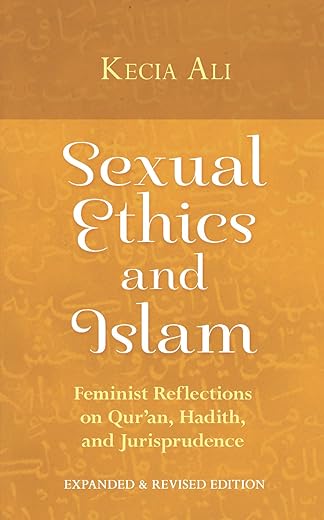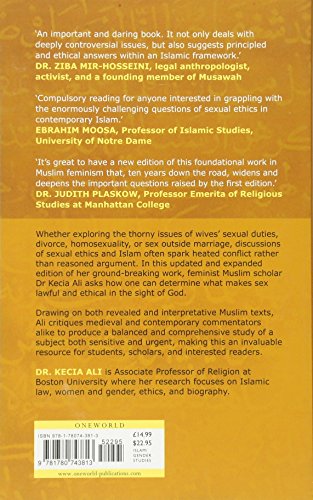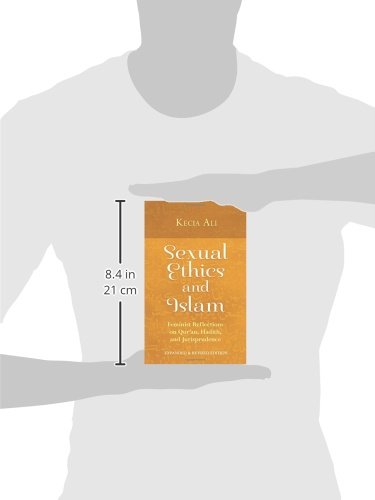Sexual Ethics and Islam: Feminist Reflections on Qur’an, Hadith, and Jurisprudence
£14.20
Whether exploring the thorny issues of wives’ sexual duties, divorce, homosexuality, or sex outside marriage, discussions of sexual ethics and Islam often spark heated conflict rather than reasoned argument. In this updated and expanded edition of her ground-breaking work, feminist Muslim scholar Dr Kecia Ali asks how one can determine what makes sex lawful and ethical in the sight of God.
Drawing on both revealed and interpretative Muslim texts, Ali critiques medieval and contemporary commentators alike to produce a balanced and comprehensive study of a subject both sensitive and urgent, making this an invaluable resource for students, scholars, and interested readers.
Read more
Additional information
| Publisher | Expanded, Oneworld Publications, Revised edition (7 Jan. 2016) |
|---|---|
| Language | English |
| Paperback | 320 pages |
| ISBN-10 | 1780743815 |
| ISBN-13 | 978-1780743813 |
| Dimensions | 13.46 x 2.54 x 21.59 cm |









by Peti
Sexual Ethics and Islam by Kecia Ali is a work of immense importance. Ali is firmly rooted in the classical works of Islamic jurisprudence and she shows enormous respect for the judgement and thinking of the ‘pre modern’ Muslim sages. Nevertheless she is very much aware of the fact that they were all men, who took it for granted that the Revelation and the life and example of Mohammed were to their benefit. My words: they were talking through their penis and thinking with their cock. However Revelation doesn’t have genitals. Ali moves carefully through her subject matter. That does her credit and also lends weight to her discourse. She is a Believer and only doubts her own judgement (every now and then). That makes her arguments strong.
Kecia Ali is one of the many radical Muslims thinkers of today. Thinkers who venture beyond the works of their pre modern colleagues and take Muslim thought into new and (in the case of the Feminists) unchartered waters. In that regard we live in very exciting times.
by Dr. Roderic Vassie
Normally I wait to finish a book before submitting my review. However, on this occasion, after only the introduction and chapter 1, I’m confident that my impression that it’s a good, thought-provoking and highly readable book will persist. Let me pick out a couple of examples of why I think so.
1. On p.19, reflecting on two contemporary fatwas from Muslim scholars in the West on the issue of the obvious imbalance between Muslim men and women in terms of their respective right (or lack thereof) to marry chaste partners from the People of the Book (i.e. Jews and Christians), bearing in mind that the Qur’an doesn’t stipulate that they be practising, Kecia Ali writes that “anecdotal evidence suggests that the first generation of Muslims viewed the preservation of an existing marriage somewhat differently that the case where no marriage yet existed.”
Although not explicitly mentioned, this anecdotal evidence includes the story of Umm Hakim, daughter of al-Harith ibn Hisham, who accepted Islam at the time of the Conquest of Mecca, while her husband, ‘Ikrimah, son of the Prophet’s PBUH infamous uncle Abu Jahl, fled to Yemen where, at the invitation of his wife, he eventually accepted Islam, such that their marriage continued. There was neither in that case nor in other similar cases any instant divorce.
On the jurisprudential implications of the particular point that “the first generation of Muslims viewed the preservation of an existing marriage somewhat differently that the case where no marriage yet existed,” my mind turned to two verses (Q.4:22 & 23), where the Qur’an makes a clear exception to rules based on the act preceding knowledge of the prohibition on Muslims marrying either their parent’s former spouse or two siblings. What is clear is the principle that the law against such marriages is not to be applied retrospectively.
2. The second issue of interest that leapt out at me related to the dower and what it was (and is) supposed to be a payment for. On p.4, Ali notes the Shafi’i definition that “graphically refers to dower as ‘the vulva’s price,’ thaman al-bud’ah,” or on p.5 that “dower came to be understood as compensation in exchange for milk al-nikah, the husband’s exclusive dominion over the wife’s sexual and reproductive capacity…” As Ali goes on to mention on p. 25, in the Coda to this second edition of chapter 1, “Rationales for specific rules may change, with dower, for instance, coming to be understood not as the exchange-value of a woman’s sex but as a provision for her financial security and a sign of the esteem in which Islam holds women…” Taken to its logical conclusion, any argument – and one still hears and reads them spouted by our fellow Muslims today – about the dower that depends on the notion of ‘compensation’ required to be paid by the husband to his wife is open to contemporary criticism that its value bears no relation to “the Market”, where a range of prices can readily be found for contracting any of the services alluded to, depending on socio-economic factors, but no one does it. And one wonders why.
Kecia Ali’s familiarity with, and command of, the writings of classical legal scholars greatly enriches the text, making it a more formidable challenge to those who would dismiss arguments based solely on an author’s assertions from Qur’anic and hadith texts, perhaps approached in translation.
I recommend this book.
by Brian Griffith
Ali updates her illuminating exploration of sexual ethics in Islam, as related to marriage, divorce, concubinage and slavery, homosexuality, circumcision, equality, and more. She explores the evolution of morality and custom as a process of collective deliberation that has led to important changes through the centuries. Her dedication to fair-minded consideration for all views makes the writing more complex than any argument for a particular set of principles. Instead of pushing answers, she raises good questions: “Who determines what is basic and cannot be changed? On what basis? Are their arguments logical and consistent? What assumptions undergird them? What hierarchies and power structures do they in turn support? What does ‘respect’ or ‘equality’ or ‘justice’ look like? Who decides?” (p. 202)